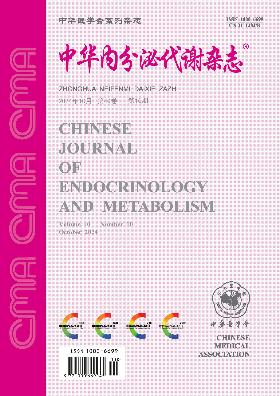老年2型糖尿病患者纤维蛋白原与微量白蛋白尿的关系
Q4 Medicine
引用次数: 0
摘要
目的分析老年2型糖尿病患者正常范围内血浆纤维蛋白原(FIB)与微量白蛋白尿的关系。方法纳入上海市第五人民医院内分泌科2012年10月至2014年10月收治的869例老年2型糖尿病患者。根据FIB的四分位数将患者分为四组:Q1组(<2.42 g/L)、Q2组(2.42-2.89 g/L)、Q3组(2.90-3.61 g/L)和Q4组(≥3.62 g/L)。分析FIB与尿白蛋白/肌酐比值(UACR)的关系。结果随着FIB的升高,UACR水平显著升高(P<0.05),多元回归分析显示FIB是UACR的独立因素(P<0.01)。Logistic回归分析显示Q4组发生微量白蛋白尿和大量白蛋白尿的风险分别为4.536倍(95%CI 2.516-8.175,P<0.01)和13.314倍(95%CI2.925-60.612,P<0.01),经性别、年龄、糖尿病病程、体重指数(BMI)、收缩压(SBP)、舒张压(DBP)、空腹血糖(FPG)、糖化血红蛋白(HbA1C)、总胆固醇(TC)、甘油三酯(TG)、低密度脂蛋白胆固醇(LDL-C)、,Cr、丙氨酸氨基转移酶(ALT),以及吸烟和饮酒行为。基于UACR 30 mg/g和300 mg/g的截止值,使用受试者工作特性曲线(ROC)来评估FIB对UACR的价值。FIB的最佳临界值分别为3.18g/L和3.22g/L。结论老年2型糖尿病患者血浆FIB与微量白蛋白尿密切相关,可作为糖尿病肾病的预测指标之一。关键词:纤维蛋白原;2型糖尿病;微量白蛋白尿本文章由计算机程序翻译,如有差异,请以英文原文为准。
Relationship between fibrinogen and microalbuminuria in elderly patients with type 2 diabetes mellitus
Objective
To analyze the relationship between plasma fibrinogen(FIB) within normal range and microalbuminuria in elderly patients with type 2 diabetes mellitus.
Methods
A total of 869 elderly subjects with type 2 diabetes mellitus admitted to the Department of Endocrinology of Shanghai Fifth People′s Hospital from October 2012 to October 2014 were included in the study. The patients were divided into four groups based on the quartile level of FIB: Q1 group(<2.42 g/L), Q2 group(2.42-2.89 g/L), Q3 group(2.90-3.61 g/L), and Q4 group(≥3.62 g/L). The relationship between FIB and urinary albumin/creatinine ratio(UACR) was analyzed.
Results
With the increasing of FIB, the level of UACR was significantly elevated(P<0.05). Pearson correlation analysis showed that FIB was positively associated with age, duration of diabetes, creatinine(Cr) and UACR in men and women(P<0.01). Multiple regression analysis showed that FIB was an independent factor of UACR(P<0.01). Logistic regression analysis showed that the risks of microalbuminuria and macroalbuminuria were respectively 4.536 folds(95%CI 2.516-8.175, P<0.01) and 13.314 folds(95%CI 2.925-60.612, P<0.01) in Q4 group, and 2.177 folds(95%CI 1.273-3.724, P<0.01) and 4.098 folds(95%CI 1.101-19.226, P<0.05) in Q3 group as compared with Q1 group after adjused by following factors: gender, age, duration of diabetes, body mass index(BMI), systolic blood pressure(SBP), diastolic blood pressure(DBP), fasting plasma glucose(FPG), HbA1C, total cholesterol(TC), triglyceride(TG), low density lipoprotein-cholesterol(LDL-C), Cr, alanine aminotransferase(ALT), as well as smoking and drinking behavior. Based on the cut off values to UACR 30 mg/g and 300 mg/g, the receiver operating characteristic curve(ROC) was used to evaluate the value of FIB for UACR. The optimal cut-off value of FIB was 3.18 g/L and 3.22 g/L respectively.
Conclusions
Plasma FIB was closely associated with microalbuminuria in elderly patients with type 2 diabetes mellitus, which may be considered as one of the predictors for diabetic nephropathy.
Key words:
Fibrinogen; Diabetes mellitus, type 2; Microalbuminuria
求助全文
通过发布文献求助,成功后即可免费获取论文全文。
去求助
来源期刊

中华内分泌代谢杂志
Medicine-Endocrinology, Diabetes and Metabolism
CiteScore
0.60
自引率
0.00%
发文量
7243
期刊介绍:
The Chinese Journal of Endocrinology and Metabolism was founded in July 1985. It is a senior academic journal in the field of endocrinology and metabolism sponsored by the Chinese Medical Association. The journal aims to be the "Chinese broadcaster of new knowledge on endocrinology and metabolism worldwide". It reports leading scientific research results and clinical diagnosis and treatment experience in endocrinology and metabolism and related fields, as well as basic theoretical research that has a guiding role in endocrinology and metabolism clinics and is closely integrated with clinics. The journal is a core journal of Chinese science and technology (a statistical source journal of Chinese science and technology papers), and is included in Chinese and foreign statistical source journal databases such as the Chinese Science and Technology Papers and Citation Database, Chemical Abstracts, and Scopus.
 求助内容:
求助内容: 应助结果提醒方式:
应助结果提醒方式:


